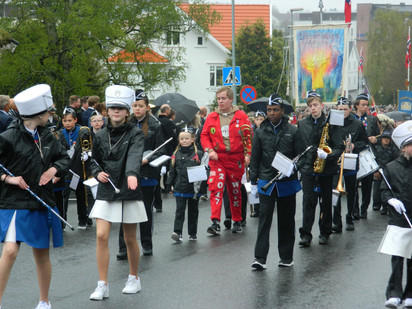A Pedacito of Syttende Mai
- Alex Gerlach
- Feb 27, 2021
- 3 min read
Updated: Jun 19, 2022
When I was a child, my grandmother would tell me stories about her native country, Norway, and her experience traveling to the states as a young girl. Hearing her speak so vividly about our family’s role in the resistance during WWII or the specifics of Norwegian culture and traditions inspired me. I wanted to know more about the country, my family, and to see it with my own eyes.
A few years back, I took a second trip to Norway to celebrate Syttende Mai with my family. Syttende Mai marks the day the country became independent from Sweden on May 17th, 1814. Like other countries, Norwegian people celebrate their independence day by wearing their country’s traditional garments, eating specific foods, and having parades. But there are a few things that make this holiday unique to Norwegian culture.

My young cousins dashed out the door the morning of Syttende Mai after breakfast, eager to take their places in the parade before it began. They, like the other children in the town, would march the streets waving flags and wearing Bunads in the Syttende Mai parade, dedicated largely to children.
I watched from the sidelines as a crowd of kids proudly flashed banners indicating their class, club, or sport. The emphasis on children during the parade is the most unique and distinguishing factor because it emphasizes the non-military nature of Norway’s independence day celebration.
High school students have their own special part of the parade called the Russ celebration. Each year, students graduating high school called Russ walk the parade wearing colored uniforms, in this case, utility jumpsuits, decorated with their names, designs, or stickers.
From the sidelines, I watched kids spray the crowd with water guns or hand out Russ cards to children. The cards are made up of the students’ names, contacts, and details; though, the information is often goofy and made up. Russ students will try to collect as many as possible to showcase their popularity; or, give the cards to younger children who will barter with them.
Whether watching or participating in the parade, people often wear Norway’s traditional garments called Bunads on Syttende Mai. They come in a variety of colors and designs that indicate what region of Norway someone hails from. Bunads consist of a few different elements that could be used to distinguish one’s marital status:
Cotton blouse
Wool skirt, vest, or trousers
Accessories like belts, shoes, purses, and shawls
Because of its unique and complex design, authentic Bunads cost thousands of dollars. They do make less expensive versions, which is what I wore on Syttende Mai.
The holiday is typically associated with hot dogs, soda, and ice cream since the holiday has a custom of “eat what you like.” Children often eat hot dogs and ice cream during the parade. Traditionally, the parade is followed by families and friends gathering to mingle and eat a light lunch. The post-parade meal typically consists of smørbrød, open-faced sandwiches, paired with coffee, tea, juice, or soda. Desserts often include more ice cream, pastries, and cakes.
The best part of visiting any country is getting an opportunity to immerse yourself in that country’s culture. Syttende Mai is a unique day full of fun, quirky customs with strong traditional roots but largely unheard of around the world. Thanks to my family, now I can share my own Syttende Mai story.
Storyteller Alex has been to Norway numerous times and visited many parts of the country. Considering a trip? Check out some other articles about traveling to Norway!
Want to know more? Are you interested in becoming a contributor for Pedacitos? We'd love to hear your stories! Send me a message and I will get back to you!































Comments